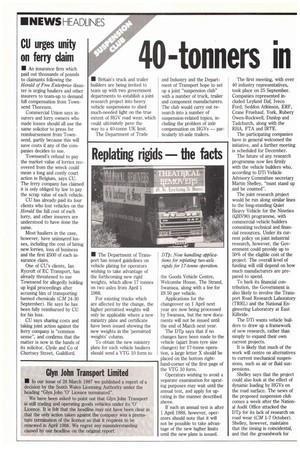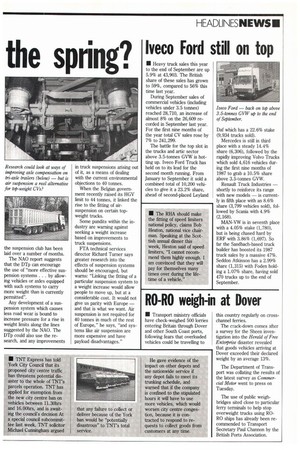40-tonners
Page 6

Page 7

If you've noticed an error in this article please click here to report it so we can fix it.
In
the spring?
• Britain's truck and trailer builders are being invited to team up with two government departments to establish a joint research project into heavy vehicle suspensions to shed much-needed light on the true extent of HGV road wear, which could ultimately pave the way to a 40-tonne UK limit.
The Department of Trade and Industry and the Department of Transport hope to set up a joint "suspension club" with a number of truck, trailer and component manufacturers. The club would carry out research into a number of suspension-related topics, including the problem of axle compensation on HGVs — particularly tri-axle trailers. The first meeting, with over 40 industry representatives, took place on 25 September. Companies represented included Leyland Daf, Iveco Ford, Seddon Atkinson, ERF, Crane Fruehauf, York, Rubery Owen-Rockwell, Dunlop and Tadchurch, along with the RHA, FTA and IRTE.
The participating companies have in general welcomed the initiative, and a further meeting is scheduled for December.
The future of any research programme now lies firmly with the vehicle builders who, according to DTI Vehicle Advisory Committee secretary Martin Shelley, "must stand up and be counted".
The joint research project would be run along similar lines to the long-standing Quiet Heavy Vehicle for the Nineties (QHV90) programme, with commercial vehicle builders commiting technical and financial resources. Under its current policy on joint industrial research, however, the Government could provide up to 50% of the eligible cost of the project. The overall level of funding will still depend on how much manufacturers are prepared to spend.
To back its financial contribution, the Government is also likely to involve the Transport Road Research Laboratory (TRRL) and the National Engineering Laboratory at East Kilbride.
The DTi wants vehicle builders to draw up a framework of new research, rather than simply to expand their own current projects.
It is likely that much of the work will centre on alternatives to current mechanical suspensions, such as air or fluid suspensions.
Shelley says that the project could also look at the effect of dynamic loading by HGVs on the road surface. The news of the proposed suspension club comes a week after the National Audit Office attacked the DTp for its lack of research on road wear (CM 1-7 October). Shelley, however, maintains that the timing is coincidental, and that the groundwork for the suspension club has been laid over a number of months.
The NAO report suggests that the DTp can encourage the use of "more effective suspension systems. . . by allowing vehicles or axles equipped with such systems to carry more weight than is currently permitted".
Any development of a suspension system which causes less road wear is bound to increase pressure for a rise in weight limits along the lines suggested by the NAO. The DTp could also use the research, and any improvements in truck suspensions arising out of it, as a means of dealing with the current environmental objections to 40 tonnes.
When the Belgian government recently raised its HGV limit to 44 tonnes, it linked the rise to the fitting of airsuspension on certain topweight trucks.
Some pundits within the industry are warning against seeking a weight increase based on improvements to truck suspensions.
FTA technical services director Richard Turner says greater research into the effects of suspension systems should be encouraged, but warns: "Linking the fitting of a particular suspension system to a weight increase would allow people to move up, but at a considerable cost. It would not give us parity with Europe — and that is what we want. Air suspension is not required for 40 tonnes in much of the rest of Europe," he says, "and systems like air suspension are more expensive and have payload disadvantages."
























































































































